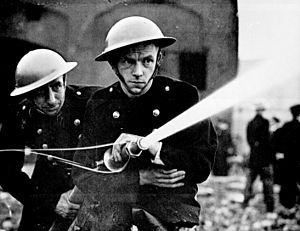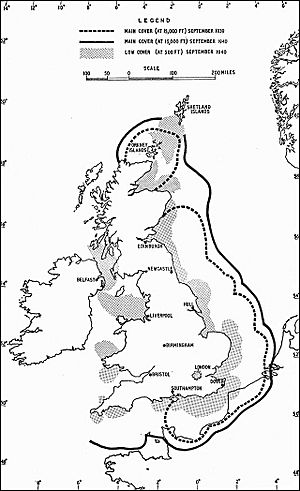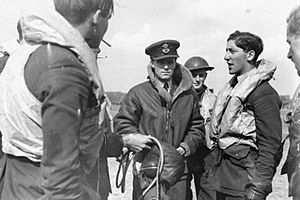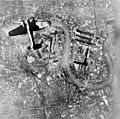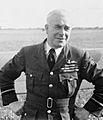Battle of Britain facts for kids
Quick facts for kids Battle of Britain |
|||||||
|---|---|---|---|---|---|---|---|
| Part of the Second World War | |||||||
 An Observer Corps spotter scans the skies of London. |
|||||||
|
|||||||
| Belligerents | |||||||
| Commanders and leaders | |||||||
| Strength | |||||||
| 1,963 serviceable aircraft | 2,550 serviceable aircraft. | ||||||
| Casualties and losses | |||||||
| 544 aircrew killed 422 aircrew wounded 1,547 aircraft destroyed |
2,698 aircrew killed 967 captured 638 missing bodies identified by British Authorities 1,887 aircraft destroyed |
||||||
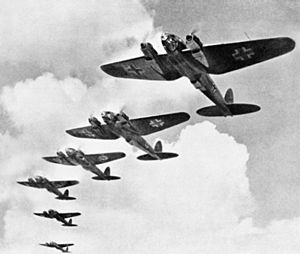
The Battle of Britain was a major air battle fought during the Summer and Autumn of 1940. It happened when the German Air Force, called the Luftwaffe, launched a huge attack on Great Britain. This battle was a key part of World War II.
Contents
What Was the Battle of Britain?
The main goal of the Luftwaffe was to take control of the skies over Britain. They wanted to defeat the Royal Air Force (RAF), especially its Fighter Command. If they could do this, Germany planned to invade Britain by sea and air.
The name "Battle of Britain" comes from a famous speech. Prime Minister Winston Churchill said: "The Battle of France is over. I expect the Battle of Britain is about to begin..."
This battle was special because it was the first major military campaign fought entirely by air forces. It was also the biggest and longest air bombing campaign up to that time.
German Attack Plan: Targeting Airfields
In July 1940, the Luftwaffe first attacked British ships along the coast. They also bombed important shipping places like Portsmouth. About a month later, the Germans changed their plan. They started attacking RAF airfields and other important military buildings. As the battle continued, they also targeted aircraft factories and ground bases.
German planes bombed coastal radar stations. At one point, only one radar mast was still working. Luckily, the British had a backup system. Human observers on the ground helped send information to the RAF Fighter Command headquarters. Many historians agree that Germany was winning during this part of the battle.
German Attack Plan: Bombing Cities
Later, the Luftwaffe changed its targets again. They started attacking towns and cities, as well as factories. This happened after the RAF bombed Berlin and German air bases in France. Adolf Hitler then ordered attacks on British cities. These attacks on civilians were meant to cause panic and lower people's spirits. This is known as terror bombing.
On September 7, 1940, a huge attack took place. Nearly 400 bombers and over 600 fighter planes targeted the docks along the Thames in London. These raids happened day and night.
The RAF's 11 Group flew up to meet the German planes. They had more aircraft than the Luftwaffe expected. Another group, 12 Group's Big Wing, took some time to get into formation. They missed their first target but found another group of bombers while still climbing.
The Luftwaffe soon stopped their morning raids. Attacks on London then started late in the afternoon and continued for 57 nights in a row.
The RAF Fighter Command had been struggling. They were low on pilots and planes. But the break from airfield attacks allowed them to recover. This meant that week by week, the British defenders became stronger. The Luftwaffe started losing more and more planes.
On September 15, the RAF stopped two massive German attacks. Every aircraft in 11 Group was used that day. On this important day, 60 German planes were shot down, compared to 26 RAF aircraft. Because of this defeat, Hitler ordered the "postponement" of his plans to invade Britain two days later. After that, facing more losses and a lack of new planes, the Luftwaffe switched from bombing during the day to bombing at night.
On September 27, a Junkers Ju 88 plane was shot down in Kent while returning from a raid on London. The German airmen survived. They fought against British soldiers who were nearby. This was said to be the first time in almost 300 years that armed invaders had fought British soldiers on British soil.
How Britain Defended Itself
The key to Britain's defense was its system for finding, commanding, and controlling its forces. This was called the 'Dowding System'. It was named after its creator, Air Chief Marshal Sir Hugh Dowding, who led RAF Fighter Command.
The most important part of Dowding's system was the use of Radio Direction Finding (RDF). This technology is now called radar (which stands for radio detection and ranging). Radar, along with information from the Royal Observer Corps, was vital. It allowed the RAF to find incoming German aircraft. Radar operators used special underground telephone lines to connect to a main control center. This center was Fighter Command control at Bentley Priory. During the battle, some units from Coastal Command and Fleet Air Arm also came under Fighter Command's control.
Fighter Planes of the Battle
The Luftwaffe used Messerschmitt Bf 109E and 110C planes. The RAF used its main plane, the Hawker Hurricane Mk I, and the less common Supermarine Spitfire Mk I. The Bf 109E could climb faster and was 10 to 30 miles per hour faster than the Hurricane, depending on how high they were flying. In September 1940, a more powerful Hurricane, the Mk IIa series 1, started to be used. It could fly up to 342 miles per hour.
The Spitfire's performance during the Dunkirk evacuation surprised the Germans. However, German pilots still believed their 109 was the better fighter. But the Bf 109E needed a much larger space to turn than either the Hurricane or the Spitfire. The two British fighters had eight Browning .303 machine guns. Most Bf 109Es had two machine guns and two cannons in their wings. Both the Bf 109E and the Spitfire were strong in different ways. For example, at certain heights, the Bf 109 could climb faster than the British fighter.
Why the Battle of Britain Was Important
The failure of Nazi Germany to achieve its goals was a huge moment. They wanted to destroy Britain's air defenses or force Britain to surrender. This failure is seen as Germany's first major defeat in the war. It was also one of the most important turning points.
If Germany had gained control of the air, Adolf Hitler might have launched Operation Sea Lion. This was a plan for a huge invasion of Britain by sea and air.
Interesting Facts About the Battle
- It was the world's first battle fought mostly in the air.
- The Battle of Britain was a major turning point in World War II. Britain stopped the Luftwaffe from destroying its air defenses. This prevented Hitler's plan to invade Britain.
- 14,286 civilians were killed during the Battle of Britain.
- Hitler first thought Britain would surrender without a fight.
- The Germans lost 1,733 aircraft and 3,893 men in the Battle of Britain.
- The Polish pilots of the 303 Squadron were very successful. They shot down 126 German planes in just 42 days.
Images for kids
-
Hawker Hurricane R4118 fought in the Battle of Britain. Here it arrives at the 2014 Royal International Air Tattoo, England.
-
X4382, a late production Spitfire Mk I of 602 Squadron flown by P/O Osgood Hanbury, Westhampnett, September 1940
-
South African Adolph "Sailor" Malan led No. 74 Squadron RAF and was, at the time, the RAF's leading ace, with 27 planes destroyed, 7 shared, 2 unconfirmed, 3 probables and 16 damaged.
-
Hermann Göring, the commander of the Luftwaffe
-
Hugo Sperrle, the commander of Luftflotte 3
-
Pattern of vapour trails left by British and German aircraft after a dogfight
-
Adolf Galland, the successful leader of III./JG 26, became Geschwaderkommodore of JG 26 on 22 August.
-
X4474, a late production Mk I Spitfire of 19 Squadron, September 1940. During the battle 19 Squadron was part of the Duxford Wing.
-
Douglas Bader commanded 242 Squadron during the battle. He also led the Duxford Wing.
-
A Bristol Blenheim Mk IV of 21 Squadron
-
German invasion barges waiting at Boulogne Harbour, France during the Battle of Britain
-
Interior of RAF Fighter Command's Sector 'G' Operations Room at Duxford, 1940
-
East Coast Chain Home radar station
-
Czechoslovak fighter pilots of No. 310 Squadron RAF at RAF Duxford in 1940
-
Pilots of 19 Squadron relax in the crew room at RAF Fowlmere, 1940
-
Polish 303 Squadron pilots, 1940. Left to right: P/O Ferić, Flt Lt Kent, F/O Grzeszczak, P/O Radomski, P/O Zumbach, P/O Łokuciewski, F/O Henneberg, Sgt. Rogowski, Sgt. Szaposznikow.
-
Pilots of No. 66 Squadron at Gravesend, September 1940
-
Heinkel He 111 bomber over the Surrey Commercial Docks in South London and Wapping and the Isle of Dogs in the East End of London on 7 September 1940
-
Air-raid shelter in London, 1940
-
A Dornier falling on Victoria Station after being rammed by Ray Holmes, 15 September 1940
-
Gun camera film shows tracer ammunition from a Supermarine Spitfire Mark I of 609 Squadron, flown by Flight Lieutenant J H G McArthur, hitting a Heinkel He 111 on its starboard quarter. These aircraft were part of a large formation from KG 53 and 55 which attacked the Bristol Aeroplane Company's works at Filton, Bristol, just before midday on 25 September 1940.
-
Commander-in-Chief, Air Chief Marshal Sir Hugh Dowding
-
10 Group Commander, Sir Quintin Brand
-
11 Group Commander, Keith Park
-
12 Group Commander, Trafford Leigh-Mallory
-
13 Group Commander, Richard Saul
See also
 In Spanish: Batalla de Inglaterra para niños
In Spanish: Batalla de Inglaterra para niños


